“Cheeky” Avians, Tahr pie and Mutton Bird
It’s summer in the Southern Hemisphere. After one of the best flights ever, I spent a few weeks in the North Island of New Zealand, then headed off to Sydney to spend Christmas and New Years with Kimberly, Eric and Eric’s family. We all enjoyed watching the fireworks from Kimberly’s apartment.


My grandsons took advantage of everything Sydney had to offer — the Australian Museum, Taronga Zoo, Aquarium, Nautical Museum, watching a day of tennis competition at 2023 United Cup, …. Sydney has an excellent transportation system, so it was quite easy to head off to both Bondi and Manly Beach for a few hours of splashing in the waves.
Kimmy’s boyfriend, Bryan, hosted all of us for a few days in Yamba, a resort town on the NE coast of Australia in the Byron Bay region. Fun fact, Byron Bay is named after Lord Byron’s grandfather who was a Vice Admiral in the British Royal Navy.
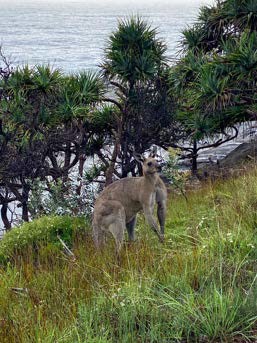
A highlight of the visit to Yamba was a morning hike where we encountered a kangaroo along the coastal trail and watched dolphins playing in the waves.
I returned to New Zealand on January 9th where, had things gone to plan, Andrea and I would have flown together to Dunedin on the South Island. Unfortunately, flights in the
U.S. were a mess. Even though Andrea was only delayed by one day, her luggage was delayed by four days. Her luggage would still be missing in action, if we hadn’t taken the initiative to personally call baggage handling in Auckland. Delays and mishaps are part of travel and add color to any story.
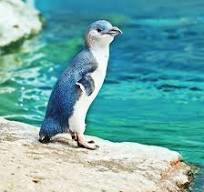
We spent a couple of days in Dunedin, with visits to both the Albatross and the little blue penguin colony. The blue penguin, is the smallest breed of penguin, less than 10” tall and under 2.2 lbs. Their Latin name, Eudyptula, means “good little diver”. It sounds so much more sophisticated in Latin. Their Māori name is kororā.
Little Blue Penguin (from web)
Dunedin has a superb French fusion restaurant, Two Chefs. This local restaurant served the best duck I had ever eaten. The dollar is quite strong, so their prices seemed extremely reasonable.
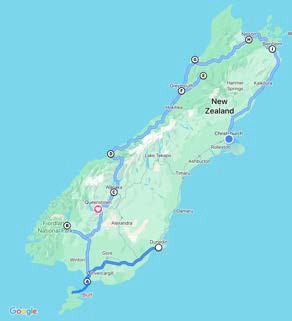
We left Dunedin on January 12th on the first driving leg of our trek 2500 km tour. At Bluff, we boarded the ferry for Stewart Island. The Foveaux Strait separates the island from the South Island of NZ. Stewart Island, at 47 degrees South, is the southern most major land mass of New Zealand. The island was initially settled by the Māori in the 14th century. The English arrived in 1826 with plans to establish a timber, flax and trading settlement.
Our South Island driving route
September, when the weather is clear and the moon is in a wax or wane cycle. 80% of the island is a National reserve and is home to the Rakiura Track, one of the “great walks” of NZ. It’s a 3 day, 32 km loop. I spent one morning slogging through 5 km of the tramping track. A trail runner can do the entire loop, depending on conditions, in less than a day.
Nearby Ulva Island is a bird sanctuary. We toured the island with a local guide. Though we spotted a few birds, it was too difficult to spot a bird, pull out my phone and grab a shot. I was quite impressed with the rat eradication program on the
The island is recognized as a Dark Sky Sanctuary and is one of the best spots for viewing the Southern Lights,
( Aurora Australis). The best time to see the Southern Lights is May to

Pillow moss on Ulva
island. The island has strategically located traps and is constantly monitored for vermin. The last rat outbreak, 1997, resulted in a local extinction of three bird sub-species. These birds, the saddleback, Stewart Island robin and yellow head, of been reintroduced and are thriving on this remote, protected speck of land.

While on Stewart Island, we sampled a local delicacy, mutton bird. New Zealand has some quaint traditions and rules that were established after the Waitangi treaty (February 1840). The treaty gave the English governance over New Zealand. There was an English and Māori version of the treaty and in recent years, the actual terms of the treaty are being contested.
Though mutton birds aren’t mentioned specifically in the treaty, in keeping with the spirit of the document, only the Rakiura Māori are allowed to harvest the bird. In April and
May, descendants of this tribe grab young birds from their nests. The tribes coordinate the harvesting with the NZ Conservatory Board.
Andrea and I shared a fried mutton bird appetizer while on Stewart Island. The meat has a seawater taste. It’s very fatty. The bird was called the mutton bird because the early settlers found the meat reminiscent of mutton.

View from Hwy 94 on the way to Milford Sound
We left the island on Sunday and headed to TeAnau, the gateway to Fiordland. I love Te Anau. It’s beauty relaxes and awakens your spirit. Andrea visited the Glow Worm cave and I walked along the Kepler track. The next day we took a trip to Milford Sound. The weather was outstanding. More importantly, I was finally able to get a picture of a NZ bird, the Kea. The Kea, along with the Weka, are quite “cheeky”, that’s the word a local resident used to describe the bird. A kea will strip away

Milford Sound

Kea in a parking lot, my first bird picture
the rubber molding from the windows or sun roof of a car. The Weka will steals your crisps or even a sandwich. These birds have absolutely no fear of humans.
While cruising on Milford Sound, we learned the difference between a sound and a fiord. A fiord is a narrow, deep inlet, formed by glacial activity. A fiord or fjord, as the Scandinavians would spell it, can be either U or V shaped. In contrast, a sound appears when a river valley is flooded and is open to the sea. Sounds are never as deep as fiords, but they are often wider. Milford and Doubtful were named by early explorers and were mischaracterized as “sounds”. By the time the geographical
error had been identified, it was too late. The name Milford Sound was recognized around the world. Milford Fiord just doesn’t sound right.
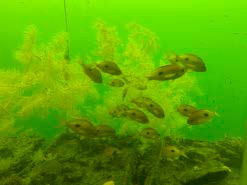
Fish as seen from Underwater Observatory
Milford “Sound” has an underwater viewing observatory where you can see Deep Water Emergent (DWE) species of fish and coral.
Though there is still debate about the conditions required for DWE, it has been identified in fiords, where freshwater meets seawater. Species which normally live at great depths survive in much shallower environments. Black Coral is known as a deep-sea coral, however, in Milford Sound it is found just 33 feet below the surface.
From Te Anau we headed off to Wānaka via Queenstown and Cardrona. Cardrona is home to a whiskey distillery. I was designated driver and Andrea was the designated taster.

Tile along the Wanaka lake walk
In Wanaka, as in every town we toured on the South Island, there is a display of civic pride. It’s seen in many ways, from tidy streets, with placards describing the town’s history to botanic gardens and ANZAC memorials. In Wanaka, there is a world timeline, tiles embedded in the lake front path highlight important world, regional and local events.
The route from Wanaka to Greymouth, via Haast, takes you through glorious glacial carved country side. There are thickly forested mountains, waterfalls and beautiful lakes. As always, pictures can not capture the magnificence of the setting.

Lake Hawea on the road from Wanaka to Haast

Miner’s cabin in Reefton
We traveled to Reefton from Greymouth. Reefton is a historic NZ mining town established during the 1860’s gold rush. It was the first city in the Southern Hemisphere to have a public electricity supply and a street lighting system. The city sponsors a Miner’s Cabin. The gentleman in the cabin answered questions about the history of the region. He was a former miner and had a natural ability to spin a tale and make history come to life.
Reefton is also home to the Little Biddy gin distillery. Our host, a young man from Scotland, guided us through the gin making process. Unfortunately, Little Biddy will never be sold in the US. The US has strict laws about gin which mandate many things, including the percentage of juniper. In NZ, several aromatics are used to flavor gin. Little Biddy’s array of flavors was impressive and tasty.

Pancake Rocks at Punakaiki
From Reefton, we backtracked through Greymouth and traveled up to Punakaiki to see the Pancake Rocks. Our visit was timed for high tide in hopes of seeing the rocks spurt water through the blowholes. The phase of the moon and the direction of the swell were wrong, so we had to be satisfied with the interesting flora, fauna and geology of the area.
We spent the night in Westport. In 1968, a series of 80 Earthquakes and aftershocks, damaged most of the town. The town was the first European settlement on the West coast with ties to both gold and coal mining. It’s situated on the mouth of the Buller River. Today, the 4,600 locals support mining, fishing, dairy and tourism.
Westport is also home to the Best Pie in NZ. The Westport Pie company makes award winning savory pies. I had a Wild Tahr pie. I had no idea what a Tahr was when I took my first bite.

Tahr

Path through Pancake Rocks
Tahrs are native to the Himalayas. In the early 1900’s a NZ landowner, in hopes of improving hunting tourism on the South Island, imported three pairs of Tahr. The tahr rapidly multiplied in the Southern Alps, so much so, as to be considered a pest. Several companies offer Tahr hunting junkets. A Bull Tahr is challenging to track and is a prized trophy. Tahr meat is delicious. It reminded me a bit of Buffalo, extremely tender without any trace of gaminess.
From Westport, we traveled on to Nelson for a few days. Nelson is probably the most bohemian town on the island. It has a very temperate climate and sits on the eastern shores of Tasman bay at the top of the South Island. It has been a haven for artists and culturally, is
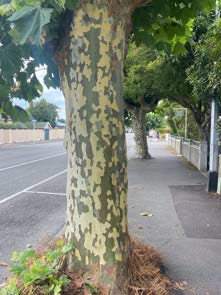
Interesting bark – Nelson
Nelson also lays claim to having the oldest wooden theater in the southern hemisphere. The theater, built in 1878, was restored in 2010.
Their cathedral has newspaper clippings from when the recently married Queen Elizabeth II visited in 1954. The local museum is interesting and has chronicles of the early settlers as well as a nice exhibit of Ernest Rutherford, the father of nuclear theory. After two attempts, he was
a bit different, from the rest of the South Island. Politically, it’s very liberal. Nelson and Dunedin both have claims of being the oldest city on the South Island. NZ City charters weren’t formalized until the 1860’s. Nelson was established in 1841 and became a city by royal charter in 1858.
Dunedin had European residents as early as 1815. It was recognized as an international whaling port in the 1830’s. But, it never requested a Royal Charter.

Nelson Cathedral
granted a scholarship to Nelson College. Persistence is necessary, even for a genius.
Saturday morning, Andrea headed for the local market and I walked along the Maitai river. The trail starts in town and along the route there were art deco public buildings, parks
and at every bend in the river, a swimming hole. The trail connects to a more extensive

system which can take you through the mountains to the west coast. I still had time to sample poffertejes, Dutch pancakes, at the market.
Path along the Maitai River in Nelson
The market is an international culinary delight. There were several custom chocolate stalls, gyros, crepes, South African biltong and Canelés. A canelé is a liquor soaked cake with a custard center covered in ganache. Its characteristic ridges provide a nearly crispy outer layer that contrasts nicely with the gooey center. It’s a French take on the Twinkie.

We had dinner at the local Whisky Cafe. Andrea had a whisky flight that she found interesting but her taste buds prefer a good bourbon. The appetizer was tempura fried pickles, interesting but difficult to eat. It was hard to bite into a pickle without the coating falling off.
From Nelson, we traveled to Blenheim where there are world renowned wineries and one of the best chocolate factories on the
planet, Makana Chocolates. After I picked up a few boxes of chocolates, we were off to the St. Claire vineyard for a delicious lunch.
The drive to Kaikōura took us down Hwy 1. Much of this route, along with the railroad line, was severely damaged in the 2016 quake. This was my first trip on the recently restored road.

Kaikoura – view from ANZAC Memorial up the coastline
Kaikoura is Māori for “eat crayfish” and that’s exactly what we did. The town’s origin story is from a Māori fable. The Māori king was traveling through the southern island searching for three of his wives who had run away. The king was tired and needed nourishment so he stopped on the peninsula and ate crayfish.
My highlight on the peninsula should have been the coastal walk, which was delightful. However, even better than a walk along the ocean, is a great football game. I was able to watch the Green Bay – SF playoff game in a local pub with two Wisconsinites and a rabid Packer fan, who was Dutch. He was on his two month paternity leave. He and his family, wife, 4 year old and 10 month old sons, were traveling around NZ.
Kaikoura, which was once a whaling port, is a haven for sperm whales. The adolescent males hang out in the waters outside the down. The peninsula trail takes you by a fur seal colony and Fyffe House. The home, built in the 1840’s, has a foundation of whale bones.
Exhibits in the home and accompanying building detail the history of the region with a focus on whaling.

Tree in Christchurch with children climbing about
Our last stop of the South Island tour was Christchurch. We were able to watch another football game, KC – Buffalo, tour the city and travel to an old French coastal town, Akaroa, for a gourmet meal at Aihe.
The Christchurch Cathedral and much of the town was severely damaged in the 2011 earthquake. Initially, a decision was made to demolish the cathedral. However, after public outcry, both pro and con, and legal challenges, the decision was reversed. The cathedral is being “restored” and should be complete in 2027.
Andrea road the street car which winds through the city and stops at all the most interesting and important places. I walked through
the botanic gardens and around the periphery of the urban center. The city was quite tidy and even the two indigents begging on the street were clean and neat. Each of them sat behind a small box. The sign behind the box requested funds as they had fallen on hard times. The sentences were neatly printed, grammatically correct and without a spelling error. I should have taken a picture!
Christchurch has a summer Shakespeare festival. The Botanic Garden has a demonstration and education series. The university hosts several lectures and events. The art museum has an eclectic collection from old masters to modern audio visual exhibits.
Christchurch is a proper city with lots to do and see.
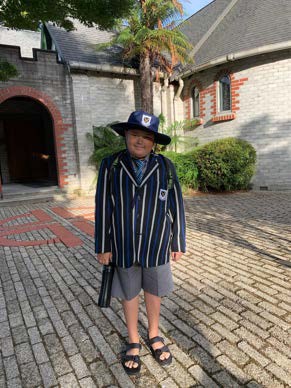
Jack in front of Southwell Chapel
Andrea and I flew back to Auckland. Andrea and her luggage headed back to the US. I was able to spend another week in NZ. Jack’s new school, Southwell in Hamilton, hosted a morning tea on his first day of class.
Jack is in year 6. The school grounds are lovely and reminiscent of a proper English boarding school.
Garret and I also visited The Hamilton Botanic Garden. This is a world class botanic park. There are several themed gardens. One of my favorite is the Chinese Scholars garden. The whimsical garden used Alice Through the Looking Glass as a theme. There is a helium filled airship, the Huddleston. This blimp can carry 600kg of cargo. The airship is used in landscaping maintenance, primarily tree trimming. When the airship isn’t in use, it’s tethered in a corner of the whimsical garden.
Before ending this report, I need to pay thanks. First of all, thank you to Andrea for being a great travel companion on our 2500 km drive around the Southern Island. Travel is more enriching when there are different perspectives and interests. I also need to thank

Zyrtec, Benadryl and CeraVe itch relief moisturizing cream. If it’s green, it makes me sneeze or causes a contact rash.
Till my next trip.